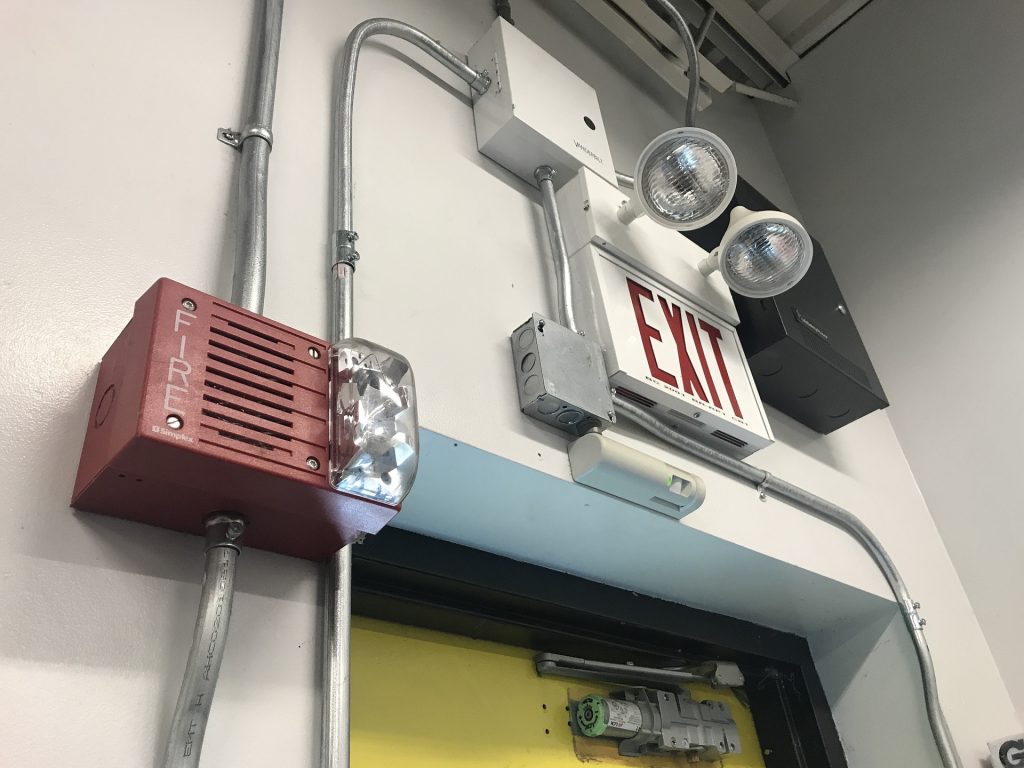How Often Should You Check Your Fire Escape Route?

Fire safety is of paramount importance for any workplace and is an ongoing requirement. Fire risk assessments should take place regularly, especially if there has been a change to the environment. Knowing the optimal fire escape routes and ensuring everybody else knows how to access them is an important part of any fire risk assessment. So, what exactly is needed in a fire safety policy and just how often should you check your fire escape route?
What Is A Fire Escape Route?

A fire escape route is the quickest path that can be taken to exit a building in case of a fire. It must be designed to cover the shortest distance possible so that people can get to a fire escape quickly, and it needs to be organised so that there are no obvious obstructions that could hinder people finding safety.
A fire safety plan lays out what will happen in the event of a fire before the emergency services arrive. Therefore, any fire escape route should be one that everyone can use to get to safety without help from fire or ambulance services.
Why Are Fire Escape Routes Important?
We all know how quickly fire can spread. Evacuating people as quickly as possible is the priority when dealing with a fire. In some cases, for example, in a single storey building with one access point, the fire escape route may be fairly obvious and easy to get to. However, many places of work are not constructed so simply, and not having a fire safety plan in place could mean people do not know how to safely get to a fire escape. These crucial minutes spent trying to find the best fire escape route could be very costly.
What To Consider In A Fire Escape Plan
A fire escape plan will take into account a number of factors, including:
- How many people are in the building? – if there are a significant number of people, these will need to be factored into a fire safety plan so that exits are optimised and routes are not blocked
- Types of people – there may be people with different access needs in the building who need additional provisions to safely leave the building
- The building itself – the age and condition of the building can determine how quickly a fire can spread. Escape routes may need extra protection
- Availability of fire exits – as a general rule, there should be a minimum of two fire exits, but more may be needed if there are large numbers of people using the building. An office block with over 600 occupants, for example, would need at least three fire exits. A fire escape plan can lay out which parts of the building use which fire exit and detail the best fire escape route to get to each
What Should Be Included With A Fire Safety Policy?

A fire safety policy will be shared by all employees so they are prepared in the event of a fire. There will need to be a competent person or a designated fire marshal who manages the fire safety policy and ensures the points outlined in the policy are put into action.
1. Fire Escape Signs
For the main entry and exit points into and out of a building, you do not need to have fire escape signs. These access points are obvious and are used by people daily. Fire escape signs must be installed for less obvious fire escape routes or for areas that might be trickier to navigate. This could include offices with multiple corridors and varying floor plans throughout. Having clearly signposted fire escape routes will help people evacuate independently as quickly as possible.
There are rules and regulations around fire escape signs that govern where they should be positioned and how high they should be. A fire safety policy will cover this level of detail and an experienced health and safety professional can make sure this is right.
2. Fire Escape Routes
As a fire escape route must be the shortest route for a person to reach safety, there are certain guidelines to follow to ensure this is the case. A fire safety policy must adhere to these guidelines when establishing the fire escape routes.
The travel distance to the nearest fire escape route will change according to how many fire exits are available:
- The shortest distance to travel should be 18 metres if there is only one fire exit
- This increases to 45 metres where there are two or more exits
- These distances are reduced if there is a higher risk of the fire spreading, for example in older buildings
This is why a fire safety policy must contain a comprehensive breakdown of all possible fire escape routes and adhere to current government legislation.
3. Fire Escape Plan
As well as listing how many fire escape signs are needed and the best escape routes, a fire safety policy will need a fire escape plan. One or more people will need to be listed as those who will carry out the plan in an emergency. Other things to include in the plan may be:
- Who will call the emergency services
- Where people will assemble after evacuating
- How to ensure everyone is accounted for
- When to use fire extinguishers or to know it is time to evacuate
Organising this information and nominating a responsible person, or persons, will reduce any panic or confusion and help to reduce the impact of a fire.
4. Fire Training
Fire training should be included in staff inductions when they first join a company. A fire safety policy should list the information to be given to new starters, including a guided demonstration of where the fire escape routes are.
It is a legal requirement to have at least one person as a designated fire officer or fire marshal on site, with one fire marshal for every 50 people. This person will need to undertake additional fire safety training. The fire safety policy may even include details of who is responsible for health and safety training at work, so that any fire training courses can be arranged and refreshed as needed.
5. Fire Safety Equipment
Fire extinguishers are crucial fire safety equipment that all workplaces must have. A thorough fire safety policy will have a breakdown of how many fire extinguishers are required in a building. There are other stipulations regarding fire extinguishers, such as:
- Each floor of a building should have at least two class A fire extinguishers
- The size of the fire extinguishers will vary according to the size of the building. They are usually available in 3 litre, 6 litre or 9 litre capacities
- There are other types of fire extinguishers that you may be required to have depending on the type of premises or business you have. These include CO2 extinguishers or wet chemical extinguishers. You may need a fire risk assessment to determine which extinguishers you need and in which sizes
So, How Often Should You Check Your Fire Escape Route?
A fire escape plan is an evolving document that will need to be updated regularly. The points above should all be reassessed and any changes made as necessary. This process will include checking all current fire escape routes. The general rule is to check the fire escape policy every 12 months. In the case of any significant changes, such as new walls being put up, an influx of new staff or new office equipment blocking a route, the fire escape policy and routes should be updated immediately to update the fire escape policy and routes.
When it comes to checking fire escape routes, this can be done on a daily basis. A quick glance over to check they are not being blocked and have a completely clear passage will help to maintain proper health and safety for all staff. Weekly checks should also ensure that:
- Any torches are working
- Fire escape doors are easy to open
- New starters know the fire escape plan
- Exit routes are clear
Fire extinguishers should be monitored monthly to check any expiry dates and make sure fire exit signs are secure and in the correct position.
Rhino Safety Can Help With Your Fire Escape And Fire Safety Policies
Putting a fire safety policy in place is not only a legal requirement, but is also essential for keeping staff safe. There are many areas to cover in a fire risk assessment; the more detailed your risk assessment, the safer your fire safety policy will be.
Rhino Safety can complete your fire risk assessment and provide you with a detailed document that includes everything you need to ensure a robust and well-planned fire safety policy. Get in touch to find out how.
